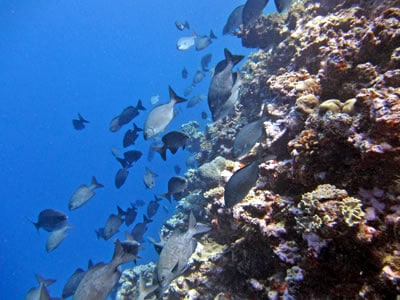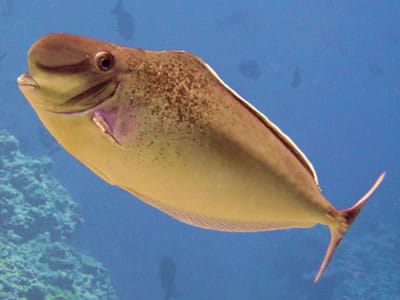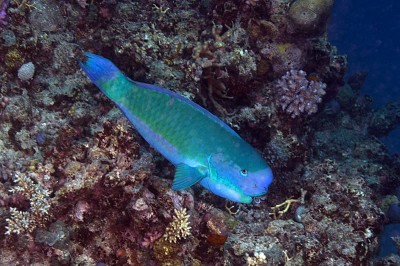As fish surveyors, our job is to identify, count, and size all the fish we see within 30m x 4 m transect lines. To do this, we drop one end of our transect tapes at 10m depth, and swim slowly along that depth contour, recording fish along the way, until we reach the end of the tape. We aim to finish three transects each per dive, and if we have time we also conduct biodiversity counts in the area. This survey approach allows us to keep our heads and eyes up, so we see a lot of neat organisms that the other surveyors miss. Here are some the most interesting and most common fish from our fish surveys so far here at the Great Barrier Reef.

School of Drummer and Black Snapper
The bulbnose unicornfish (Naso tonganus) is commonly seen swimming high above the reef and will often form schools of about 10 individuals or more. The fish are rather large, reaching a maximum of 60 cm. They are most commonly seen on the outer reefs, especially in areas with steep slopes. Their size, along with their unique facial structure, adds drama and a hint of comedy to many of our fish surveys.

Bulbnose Unicornfish (Naso tonganus)
Steephead parrotfish (Chlorurus microrhinos) are also large and often form large schools high above the reef. They use their large plated teeth to scrape algae off of hard surfaces, and often take off large chunks of coral and rubble in each bite. They digest the algae and the coral gets broken down to create much of the sand on the reef (this is the powder you see in the photo). These fish are some of the biggest bioeroders on the reef, breaking down huge amounts of hard substrate per year.

Steephead Parrotfish (Chlorurus microrhinos)
Blacksaddled coralgroupers (Plectropomus laevis) are tricky to identify, because they can take on a variety of colors. This particular fish has a relatively dark coloration, but fish of the same species also sometimes appear milky white, with dark black saddle markings and yellow fins, or light grey all over. So instead of relying on coloration, we use body shape to identify these fish. They’re usually found hovering close to the reef, and even though they have big scary teeth, they can be very skittish around divers.

Blacksaddled Coralgrouper (Plectropomus laevis)
Photos: 1,2,4 – Katie Lubarsky; 3 – Ken Marks